|
|
| Year |
1995 |
| Price |
£1,300 (£2,500 today) |
| Manufacturer |
Siemens Nixdorf |
| CPU |
Pentium MMX 233mHz |
| RAM |
32MB |
| HDD |
20GB |
| Video |
Tseng Labs ET-4000 |
| Sound |
TBC |
| OS |
Windows 95 |
|
This beautifully unique PC was way ahead of it's time. In a world of beige boxes, this inspiring PC came in several colours and styles and
featured a wireless trackpad/gamepad, built in mic & speakers, clutter-free cables and a game port on the front. Available in
desktop, midi tower and SFF - the midi tower was the first PC my parents bought me as a kid, I remember seeing it in Escom and being blown away by it's looks.
Design
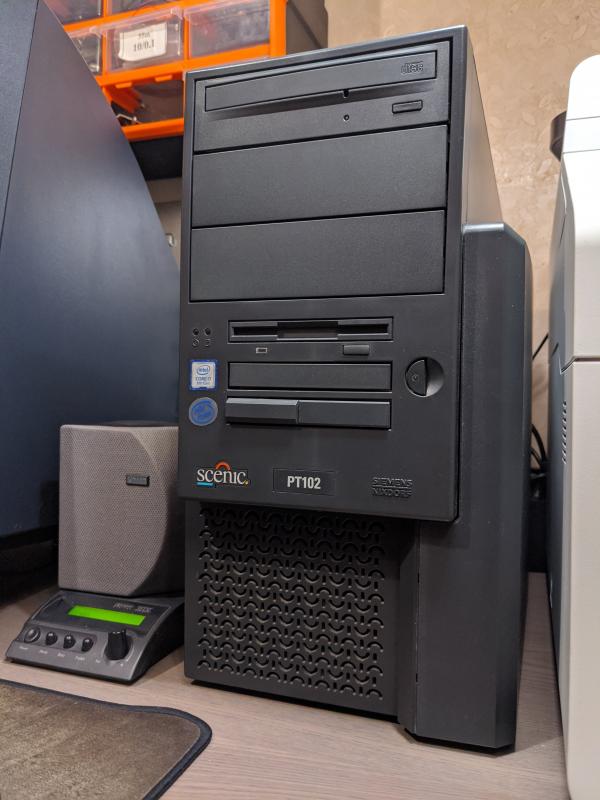
The range included three form factors: PT (midi tower), PD (desktop) and PS (small form factor). Each one available in either a cool white and light blue combo or the moody blue and dark blue/black.
The outstanding design comes from Frog Design Inc. who were also responsible for the Apple IIc and the NeXTcube. The great design didn't end with the aesthetics,
a lot of thought also went into to construction and usability. It's the little touches that I love like the mic and speakers built into the monitor. The speakers are removable if you're not a
fan of the Dumbo look. They are attached with 2 stainless steel hex screws, that's it, no wires to mess around with. The 2 screws are also the + and - terminals of the speakers, genius!
Everywhere you look there are little optimisations like this. The mic and speaker cables are integrated into the single VGA signal cable that goes from the monitor to the PC.
The mouse plugs into the keyboard and this plugs in to the PC with, what appears to be, a regular PS/2 cable. The PC has both KB and mouse PS/2 ports and accepts any normal KB and mouse as well as
the Siemens single cable version.
The PC also has a 3 pin mains power cable out to the monitor, which was quite common at the time. The end result is a very simple and tidy setup, with the minimal amount of cables
cluttering up your workspace.
Ahead of it's time
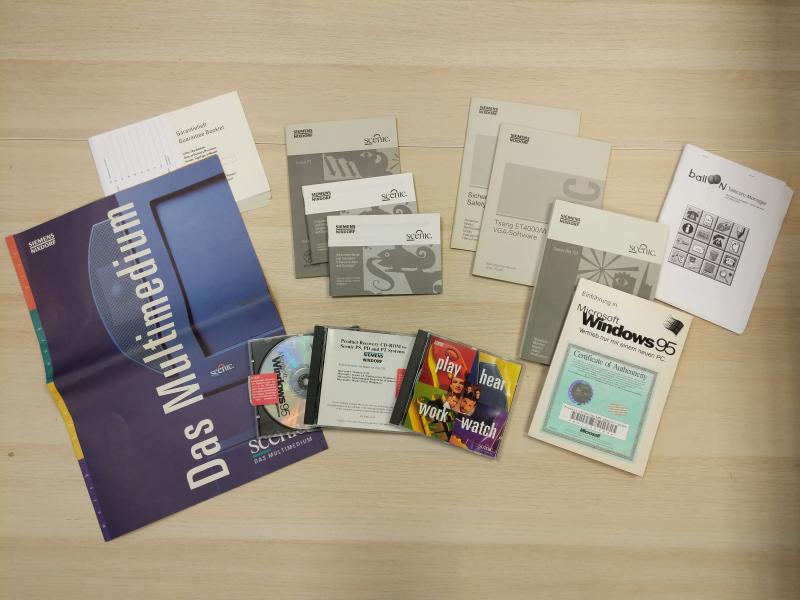
Not only did these PCs look ahead of their time, they included some features from the future too. At the time, most PCs used AT power supplies, which feature a physical mains power switch on the font of the
case. This meant that you couldn't power them on and off using software. Remember "It's now safe to turn off your computer"? Siemens used an AT power supply that plugged in to the motherboard with standard
AT headers, but they included an extra 3 pin connection. This provided a permanent 5V feed to the motherboard and allowed the PC to turn the power supply on and off via software. This is part of the modern ATX
standard and in every PC today, but back in 1996, it was amazing to see a PC that could turn itself on and off. Not only could you shut down Windows and have the PC turn itself off, you could set an alarm-clock in
BIOS to turn the PC on automatically and even the internal fax/modem could wake up the PC if someone rang your land line. Crazy!
Gaming from your sofa
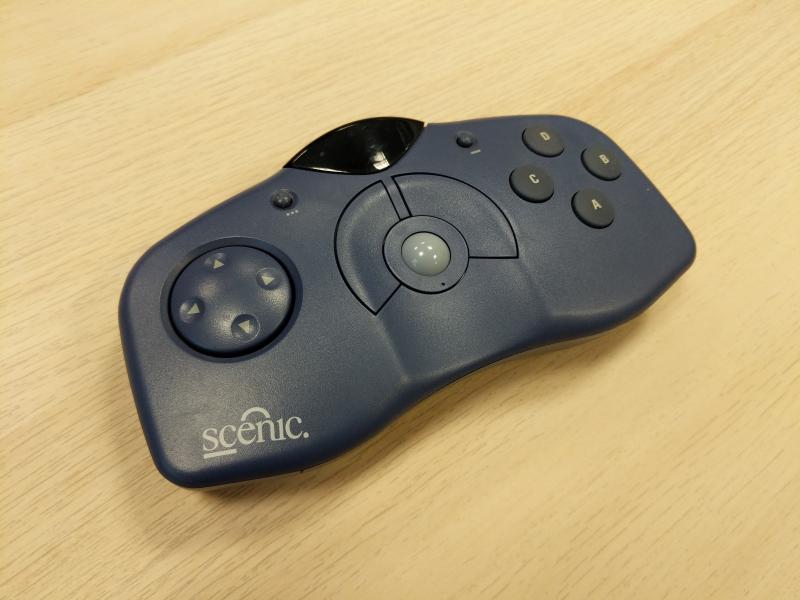
You also got an infrared gamepad / trackball. As a teenager in 1996 this was just the coolest thing in the world. Everyone else had an ugly beige box and a clunky keyboard attached with
a big thick springy telephone cable sat on a desk in the corner of the room. Not the Scenic though, you could kick back in bed and navigate the point a click interface that came bundled on top of Windows
launch your favourite game and play Micro Machines or Duke Nukem 3D using the gamepad, then shut everything down and fully power off the PC without getting up.
As cool as this was this is the one part of the system that was let down by a bit of bad design, it kind of felt like an afterthought. The IR receiver integrated into the monitor nicely, but then you had to run
a separate cable tot he PC. Bearing in mind, all the other signal wires were integrated in to one cable and the received sat right on top of the monitor, so the thick winding cable was always on show. Such a shame
after the slick cable-fee speakers. Also, with the IR receiver located at the top of the monitor, the gamepad rarely worked if you were sat down near the PC. You generally hold the gamepad in your lap and it needs
line-of-sight to the receiver, which is now a few feet higher up than the gamepad, with a desk and keyboard in the way.
There was also a front mounted game port, so you could easily plug your gamepad or flight stick in without fumbling behind the back of the PC, it's such a simple thing but it really made a big difference.
Skeuomorphism
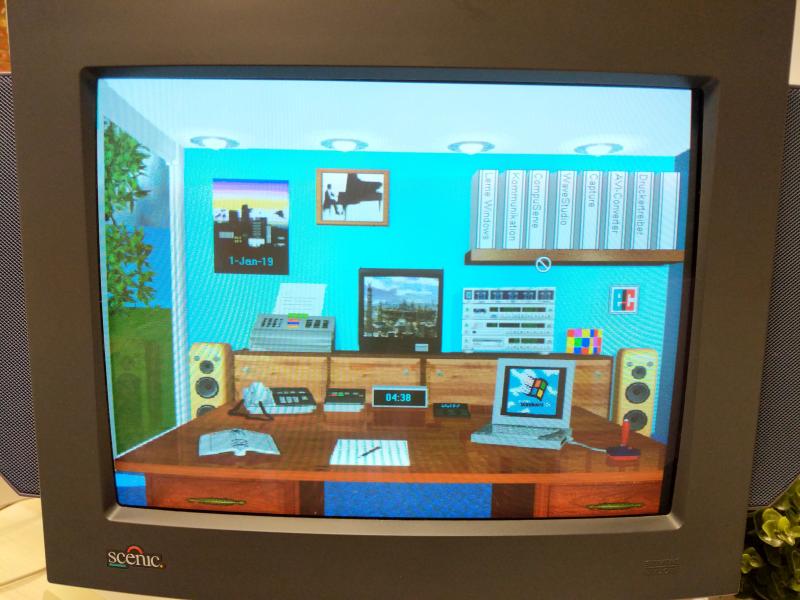
A Skeuomorphic user interface, is one that emulates real-world objects, like the recycle bin in Windows. Out of the box these Scenics came with a piece of software installed called Phoenix Home Office. The
application ran on top of Windows, started automatically and took over the entire scree, replacing the Windows desktop and start menu. It was a graphical image of a virtual office, complete with a desk,
bookshelves, calendar, clock, posters, rolodex and much more. Clicking on the different things on your screen ran the appropriate app. It was incredibly simple program really, just a single static image with
clickable regions. You could configure what programs were launched if you didnt like the defaults.
So ultimately it did nothing more than the windows start menu, in fact it did a lot less, but it was somehow about as awesome at the 90s could get.
My Story
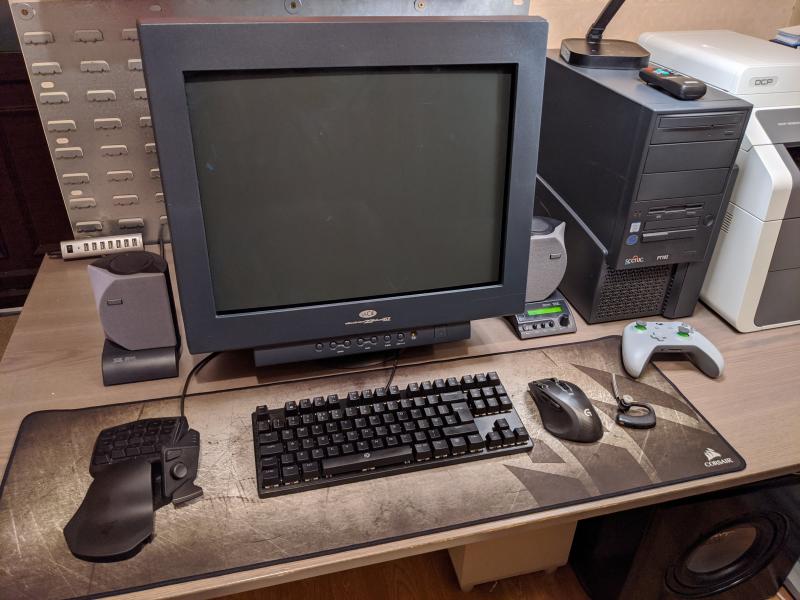
I now own 2 of these machines, the PD-101 desktop and the PT-102 midi tower. The desktop has all the original accessories, software and docs. The tower has been fitted out with modern hardware
paired with a 22" LaCie CRT, modern gaming KB and mouse, 90s Altec Lansing THX surround system and is my current gaming rig. There's a really interesting story behind how I managed to track down these PCs
and a few surprises happened align the way. I'll update this page soon, so please check back.
|